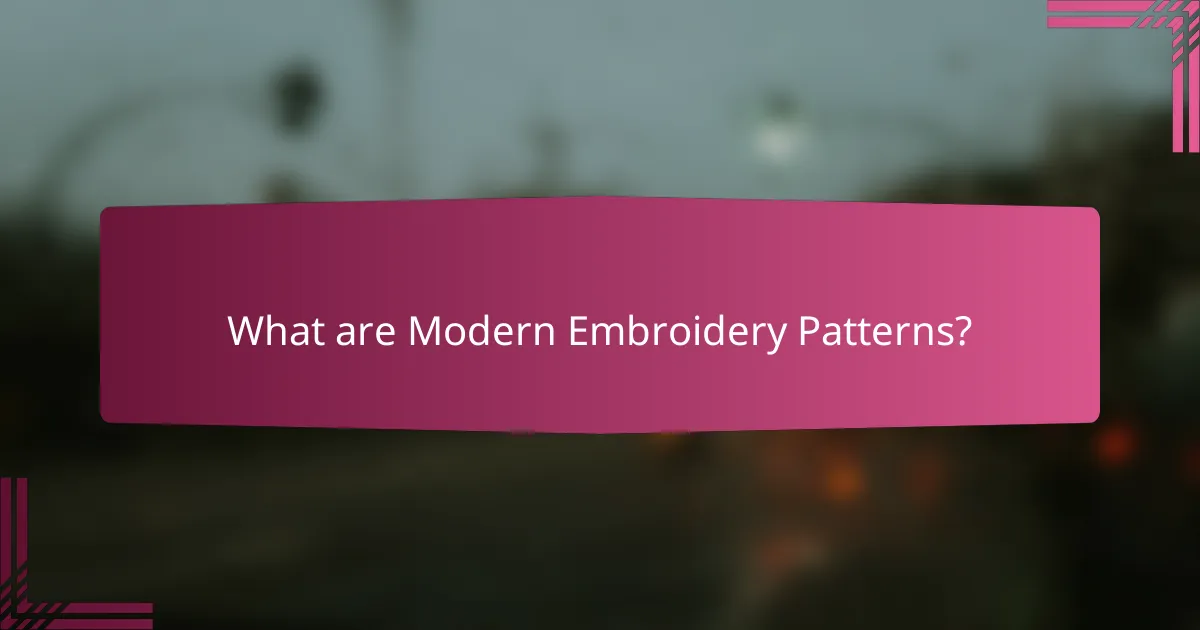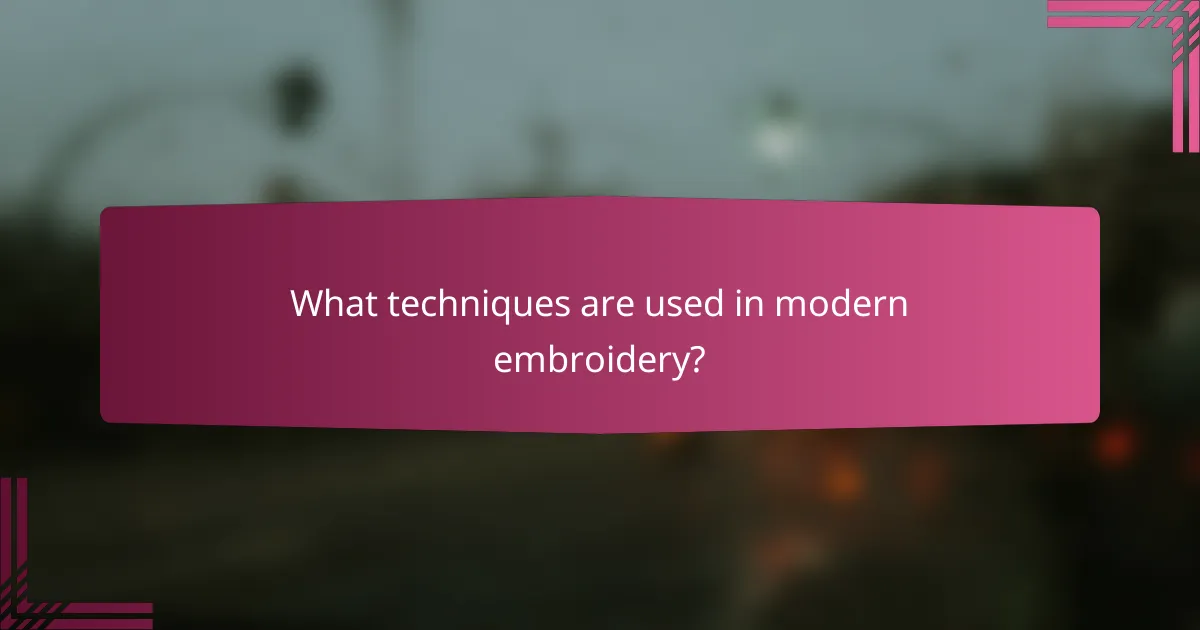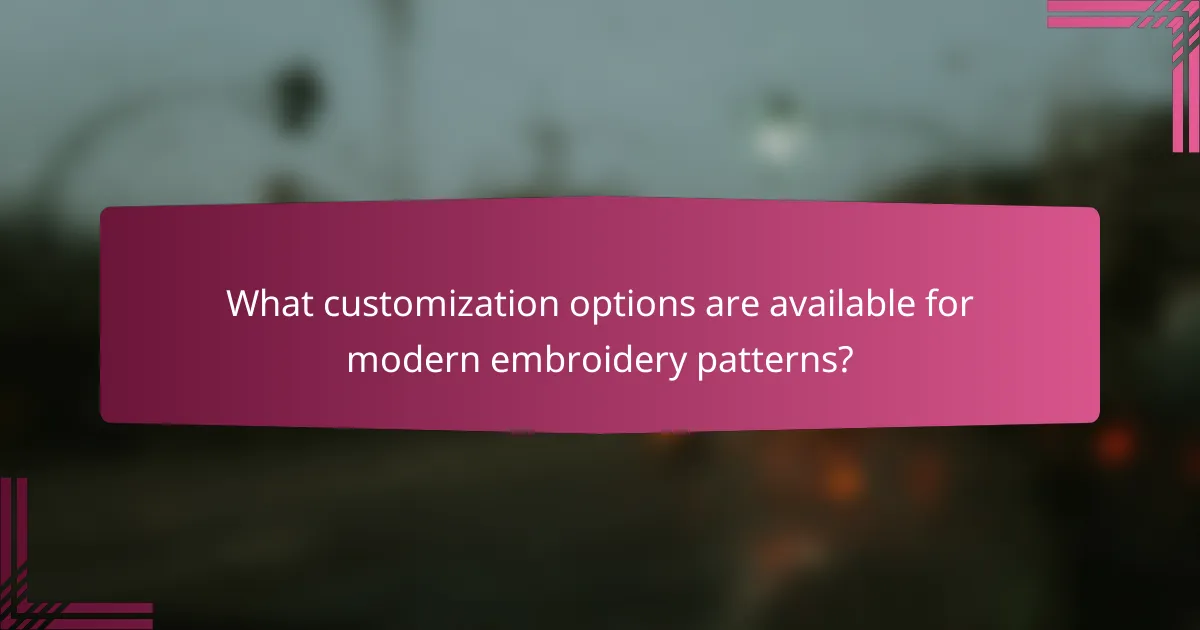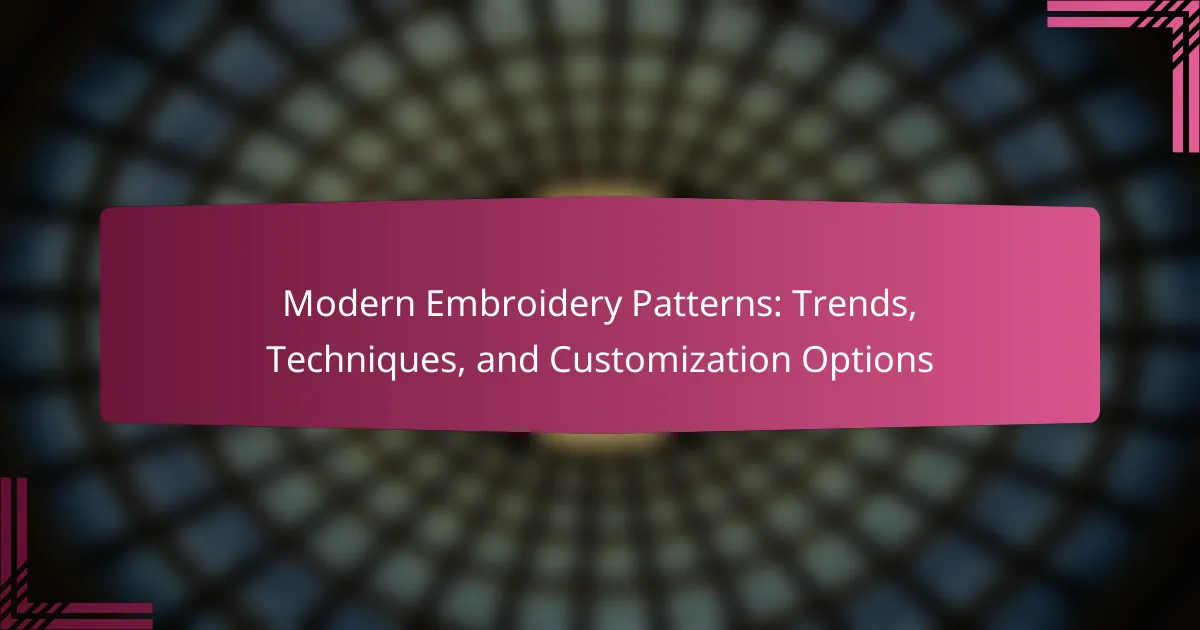
What are Modern Embroidery Patterns?
Modern embroidery patterns are contemporary designs used in the art of embroidery. These patterns often incorporate innovative techniques and styles. They reflect current trends in fashion and home decor. Modern patterns can range from geometric shapes to intricate floral designs. Many patterns are created digitally, allowing for precise and customizable options. The use of vibrant colors and mixed media is common in modern embroidery. These patterns cater to both traditional and avant-garde tastes. They are popular among crafters and artists for their versatility and creativity.
How have modern embroidery patterns evolved over time?
Modern embroidery patterns have evolved significantly over time due to technological advancements and cultural influences. Traditional hand-embroidery techniques have been supplemented by machine embroidery, allowing for greater precision and speed. Digital design software has enabled intricate patterns that were previously difficult to achieve by hand. The rise of social media has popularized diverse styles and trends, fostering a global exchange of ideas. Contemporary patterns often incorporate mixed media, blending embroidery with other textile arts. Sustainability has also influenced modern designs, with a focus on eco-friendly materials and practices. Overall, modern embroidery reflects a fusion of tradition and innovation, adapting to current artistic expressions and consumer preferences.
What historical influences shaped contemporary designs?
Contemporary designs are shaped by various historical influences, including art movements and cultural practices. The Arts and Crafts Movement emphasized craftsmanship and natural forms, impacting modern design aesthetics. Bauhaus introduced functionalism and simplicity, which are evident in today’s minimalist designs. Folk art traditions contribute vibrant patterns and motifs to contemporary embroidery. Additionally, globalization has facilitated the exchange of design ideas across cultures. The revival of vintage styles reflects nostalgia and appreciation for past techniques. These historical influences collectively inform the visual language and techniques used in modern embroidery patterns.
What are the key characteristics of modern embroidery patterns?
Modern embroidery patterns are defined by their innovative designs and techniques. They often feature bold colors and intricate details. Geometric shapes and abstract motifs are commonly used. Additionally, modern patterns showcase a mix of traditional and contemporary styles. Digital technology plays a significant role in their creation. This allows for precise and complex designs that were previously difficult to achieve. Sustainable materials are increasingly incorporated into these patterns. This trend reflects a growing awareness of environmental impact in the craft. Overall, modern embroidery patterns emphasize creativity and personalization.
Why are modern embroidery patterns popular today?
Modern embroidery patterns are popular today due to their versatility and aesthetic appeal. They cater to a wide range of tastes and styles. Many people appreciate the blend of traditional techniques with contemporary designs. This fusion creates unique pieces that stand out. Additionally, the rise of DIY culture has increased interest in embroidery. Accessible resources and tutorials make it easier for beginners to start. Social media platforms showcase these patterns, inspiring creativity. Trends often highlight personalization, allowing individuals to express themselves. The growing demand for handmade items also contributes to their popularity.
What trends are driving the resurgence of embroidery?
The resurgence of embroidery is driven by the growing interest in handmade crafts and personalization. Many consumers seek unique, custom-made items that reflect their individual style. The rise of social media platforms has made it easier for artisans to showcase their work and connect with a broader audience. Additionally, sustainability concerns have led to a preference for eco-friendly, locally sourced materials in crafting. The pandemic has also increased the popularity of DIY projects as people spend more time at home. According to a survey by the Craft and Hobby Association, 70% of respondents expressed interest in learning new crafting skills, including embroidery. This indicates a strong market demand for embroidery-related products and education.
How do social media and technology impact embroidery trends?
Social media and technology significantly influence embroidery trends by enabling broader access to designs and techniques. Platforms like Instagram and Pinterest showcase diverse embroidery styles, inspiring creators worldwide. This exposure leads to increased experimentation with techniques and patterns. Technology facilitates the use of digital tools like embroidery software, allowing for precise design creation. Additionally, online communities foster collaboration and knowledge sharing among embroidery enthusiasts. The rise of e-commerce platforms has made unique embroidery supplies more accessible. As a result, trends evolve rapidly, reflecting a blend of traditional and contemporary influences.

What techniques are used in modern embroidery?
Modern embroidery employs various techniques including machine embroidery, hand embroidery, and digital embroidery. Machine embroidery uses computerized machines to create intricate designs quickly. Hand embroidery involves manual stitching techniques, allowing for personalized and artistic expression. Digital embroidery integrates technology, enabling precise designs and patterns. Other techniques include appliqué, where fabric pieces are sewn onto a base fabric, and free-motion embroidery, which allows for creative stitching without a fixed pattern. These techniques enhance the versatility and creativity of modern embroidery.
How do traditional techniques compare to modern approaches?
Traditional techniques in embroidery often emphasize hand-stitching and intricate designs. These methods have been passed down through generations, showcasing cultural heritage. In contrast, modern approaches incorporate technology, such as machine embroidery and digital design software. This allows for faster production and more complex patterns. Traditional methods may require more time and skill, while modern techniques focus on efficiency and scalability. A study by the Embroidery Association in 2022 found that machine embroidery can reduce production time by up to 70%. Thus, traditional techniques prioritize craftsmanship, while modern approaches value speed and accessibility.
What are the most popular stitching techniques in modern patterns?
The most popular stitching techniques in modern patterns include satin stitch, backstitch, and French knots. Satin stitch is widely used for filling in shapes and providing a smooth finish. Backstitch is favored for outlining and creating defined lines. French knots add texture and dimension to designs. Other notable techniques include chain stitch and whip stitch, which offer unique visual effects. These techniques are prevalent in contemporary embroidery due to their versatility and ease of use. Their popularity is also supported by the growing interest in DIY embroidery projects and customization in fashion.
How can one learn these techniques effectively?
To learn modern embroidery techniques effectively, one should engage in structured practice and utilize resources. Joining embroidery classes or workshops provides hands-on experience. Online tutorials and video guides offer visual learning and step-by-step instructions. Practicing regularly enhances skill retention and muscle memory. Experimenting with different patterns fosters creativity and adaptability. Engaging with embroidery communities encourages feedback and support. Research shows that active participation in community learning increases proficiency. According to a study by the Journal of Textile and Apparel Technology and Management, consistent practice leads to improved technique mastery.
What role do tools and materials play in modern embroidery?
Tools and materials are essential in modern embroidery, significantly influencing the quality and creativity of the final product. High-quality threads, fabrics, and needles enhance durability and appearance. Specialized tools like embroidery machines automate and streamline the process, allowing for intricate designs. Various materials, such as stabilizers and hoops, provide support and structure during stitching. The choice of tools and materials can also affect the texture and finish of the embroidery. For instance, using cotton threads can produce a different look compared to polyester threads. Innovations in tools, such as digital embroidery software, enable customization and precision. Overall, the right combination of tools and materials elevates modern embroidery, making it both an art and a craft.
What types of fabrics are best suited for modern embroidery patterns?
Cotton and linen are the best fabrics for modern embroidery patterns. These materials provide a stable surface for stitching. They allow for vibrant colors and intricate designs. Additionally, cotton is widely available and easy to work with. Linen offers a unique texture that enhances embroidery. Other suitable fabrics include polyester and denim. Polyester is durable and resists wrinkles. Denim provides a sturdy option for bold designs. Each fabric type contributes to the overall aesthetic and quality of the embroidery.
How do different threads affect the final embroidery design?
Different threads significantly impact the final embroidery design. The type of thread used influences texture, sheen, and color vibrancy. For instance, rayon threads provide a high sheen, enhancing the design’s visual appeal. Cotton threads, on the other hand, offer a matte finish, resulting in a more subdued look. Additionally, thicker threads can create raised effects, adding dimension to the design. The choice of thread also affects durability; polyester threads are often more resistant to fading and wear compared to cotton. Furthermore, the thread’s weight can alter the stitch density, impacting the overall appearance and intricacy of the design.

What customization options are available for modern embroidery patterns?
Modern embroidery patterns offer various customization options. These include selecting thread colors, adjusting pattern sizes, and choosing fabric types. Users can also modify stitch types and densities. Personalization options allow for the inclusion of names or initials. Software tools enable users to create unique designs from scratch. Additionally, some platforms provide access to pre-made templates for further customization. The ability to combine multiple patterns enhances creative possibilities. These options cater to individual preferences and project requirements.
How can individuals personalize their embroidery projects?
Individuals can personalize their embroidery projects by selecting unique designs and colors. They can create custom patterns that reflect personal interests or themes. Using initials or names adds a personal touch to the embroidery. Choosing specific fabric types can enhance the project’s uniqueness. Incorporating meaningful symbols or motifs can also personalize the work. Additionally, individuals can experiment with different stitching techniques for a distinctive look. Customization options allow for creativity and self-expression in embroidery projects.
What software or tools assist in creating custom designs?
Software tools that assist in creating custom designs include Adobe Illustrator, CorelDRAW, and Canva. Adobe Illustrator is widely used for vector graphics and design. CorelDRAW offers robust features for graphic design and layout. Canva is popular for its user-friendly interface and templates. These tools enable designers to create intricate and personalized designs efficiently. They support various file formats and are compatible with embroidery machines. Many professionals rely on these software options for their versatility and functionality in design creation.
How do color choices impact the overall look of a pattern?
Color choices significantly impact the overall look of a pattern. Colors can evoke emotions and set the tone of the design. For instance, warm colors like red and orange create a sense of energy. In contrast, cool colors such as blue and green convey calmness. The combination of colors also affects visual harmony. Complementary colors enhance vibrancy, while analogous colors provide a more cohesive look. Additionally, the saturation and brightness of colors can alter perception. High saturation colors draw attention, while muted tones can create subtlety. Studies show that color combinations can influence viewer engagement and interpretation. Thus, strategic color choices are essential in modern embroidery patterns.
What are the best practices for customizing modern embroidery patterns?
The best practices for customizing modern embroidery patterns include selecting a suitable design, choosing the right fabric, and using quality thread. Start by picking a design that aligns with your vision. Ensure the fabric complements the design and is appropriate for embroidery. Use high-quality thread to enhance durability and appearance. Adjust the pattern size to fit your project requirements. Consider color schemes that reflect your style and the intended use. Test the design on a scrap piece of fabric before finalizing. This approach minimizes errors and allows for adjustments. Following these practices leads to successful and personalized embroidery projects.
How can one ensure quality in custom embroidery work?
To ensure quality in custom embroidery work, select high-quality materials and threads. Quality fabrics reduce fraying and enhance the final look. Use professional embroidery machines for precision and consistency. Skilled operators can adjust settings for different fabrics. Regular maintenance of equipment prevents issues during production. Conduct a thorough quality check before final delivery. This includes inspecting for thread tension and alignment. Following these steps leads to superior embroidery results.
What common mistakes should be avoided during customization?
Common mistakes to avoid during customization include overlooking design compatibility. Ensuring that the chosen designs fit well with the fabric is crucial. Failing to consider the fabric type can lead to poor results. Another mistake is neglecting the importance of thread quality. Using low-quality thread can affect the durability and appearance of the embroidery.
Inadequate planning of the embroidery layout is also a frequent error. Proper layout planning helps in achieving a balanced and aesthetically pleasing design. Ignoring the size of the embroidery can lead to disproportionate results. It is essential to scale designs appropriately for the intended area.
Lastly, not testing the design before full production is a critical mistake. Conducting a test run can help identify potential issues. This ensures that the final product meets expectations.
What tips can enhance the experience of working with modern embroidery patterns?
To enhance the experience of working with modern embroidery patterns, start by selecting high-quality materials. Using premium threads and fabrics improves the final look. Familiarize yourself with the pattern instructions thoroughly before beginning. This ensures you understand all steps and techniques involved. Utilize embroidery software for design adjustments. Software can help customize patterns to your preferences. Maintain an organized workspace to minimize distractions. A tidy area allows for better focus and efficiency. Experiment with different stitches and techniques. This exploration can lead to unique results and personal style. Lastly, join online communities or forums. Engaging with others can provide support and inspiration.
Modern embroidery patterns are contemporary designs that incorporate innovative techniques and styles, reflecting current trends in fashion and home decor. This article explores the evolution of these patterns over time, highlighting key historical influences and characteristics that define modern embroidery. It also examines popular stitching techniques, customization options, and the impact of social media and technology on embroidery trends. Additionally, the article provides practical tips for enhancing the embroidery experience while avoiding common mistakes, ensuring quality in custom work. Overall, it serves as a comprehensive guide to understanding and engaging with modern embroidery.
